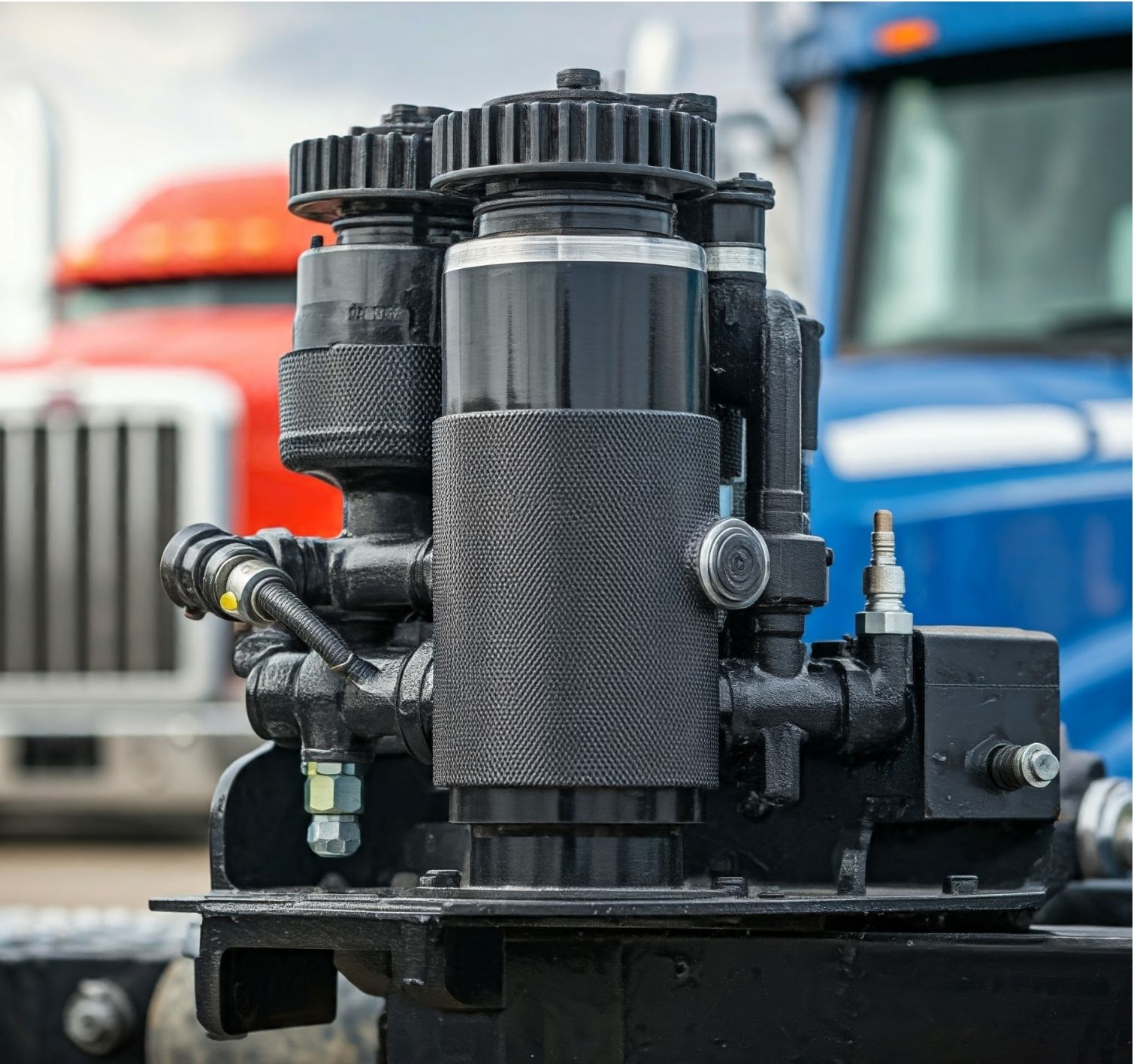
Common Air Dryer Problems and Solutions
Air dryers play a vital role in American truck brake systems by removing moisture from compressed air. This function ensures efficient and safe braking, as excess moisture can cause internal corrosion and freeze within brake components. However, air dryers can encounter issues that compromise their performance, leading to potential risks. Here, we’ll cover common air dryer problems, troubleshooting tips, and the importance of regular inspections to maintain reliable brake function.
1. Desiccant Cartridge Failure
Problem Overview
The desiccant cartridge, which absorbs moisture from compressed air, is crucial for keeping the air brake system dry. Over time, the desiccant material can become saturated or contaminated, reducing its effectiveness. This can result in residual moisture in the system, causing corrosion or freezing in colder temperatures.
Signs of Desiccant Cartridge Failure
- Increased moisture in the air brake system.
- Corrosion in air tanks and other components.
- Freezing issues during winter months.
- Shortened brake response time due to restricted airflow.
Troubleshooting and Solutions
- Replace the Desiccant Cartridge Regularly: Most manufacturers recommend changing the desiccant cartridge every 12-24 months, depending on usage and environmental conditions. However, frequent exposure to humid environments may require more frequent replacements.
- Inspect for Contamination: Look for oil or debris buildup in the cartridge. This could indicate a faulty compressor or leaks, which should be addressed to prevent recurring desiccant contamination.
- Check Purge Cycle Frequency: If the air dryer purges too often, it can reduce the lifespan of the desiccant cartridge. Make sure the purge cycle matches your vehicle’s operating environment.
Maintenance Best Practices
- Schedule desiccant replacements as part of your regular maintenance routine.
- After replacing, test the air dryer system to confirm the desiccant is properly filtering moisture.
- Keep a log of desiccant cartridge replacements to monitor performance over time.
2. Purge Valve Problems
Problem Overview
The purge valve allows moisture and contaminants to be expelled from the air dryer. If it malfunctions, moisture can accumulate within the system, potentially freezing and obstructing airflow. Common causes of purge valve issues include debris buildup, mechanical wear, and insufficient lubrication.
Signs of Purge Valve Problems
- Frequent purge valve activation or failure to activate.
- Moisture accumulation in air tanks.
- Unusual noises from the air dryer, such as hissing or clicking.
- Reduced brake performance, especially in cold weather.
Troubleshooting and Solutions
- Inspect and Clean the Purge Valve: Regularly remove debris from the valve to prevent clogs. For extensive wear or damage, consider a replacement.
- Ensure Proper Lubrication: A lack of lubrication can cause purge valves to stick. Use manufacturer-recommended lubricants to avoid potential freezing or sticking.
- Monitor Pressure Settings: An incorrect pressure setting can cause premature purge cycles, affecting performance. Check the pressure range and adjust it to match the system’s requirements.
Maintenance Best Practices
- Clean the purge valve during every major inspection.
- Replace purge valves at the first signs of damage to avoid system contamination.
- Test purge valve function after cleaning to ensure it operates correctly.
3. Heater Malfunctions
Problem Overview
In colder climates, the air dryer’s heater keeps moisture from freezing within the unit. If the heater fails, moisture can freeze, blocking the airflow and preventing efficient braking. Causes of heater malfunction can include electrical issues, fuse problems, and wiring failures.
Signs of Heater Malfunctions
- Air dryer freeze-ups in cold weather.
- Extended brake reaction time due to restricted airflow.
- Electrical issues or blown fuses in the air dryer system.
- Unusual cold spots around the dryer unit.
Troubleshooting and Solutions
- Check Electrical Connections: Loose or corroded connections can prevent the heater from operating correctly. Inspect wiring for damage and repair as necessary.
- Inspect Fuses and Relays: If the heater doesn’t work, check for blown fuses or faulty relays. Replace these components if needed.
- Monitor Temperature Control: Ensure the heater’s thermostat is correctly calibrated to activate at the appropriate temperature.
Maintenance Best Practices
- Inspect heater function before each winter season to prevent freeze-ups.
- Test the thermostat periodically to verify it’s operating within the specified temperature range.
- Replace any damaged or aged electrical components to maintain reliable heater performance.
4. Importance of Regular Air Dryer Inspections and Replacements
Prevent Moisture Buildup and Corrosion
Air dryers are fundamental to the health of the brake system. By removing moisture, they prevent rust, corrosion, and deterioration of air brake components. Regular inspections allow drivers to catch early signs of air dryer failure, saving time and money on costly repairs later.
Ensure Optimal Brake Performance
Moisture or freezing in the air brake system can lead to extended braking distances, which are hazardous in emergency stops. Well-maintained air dryers help ensure that braking performance is not compromised, especially under adverse weather conditions.
Avoid Unscheduled Downtime
Unexpected air dryer malfunctions can lead to sudden truck breakdowns, causing costly delays and affecting delivery schedules. Routine inspections and timely replacements reduce the risk of unscheduled downtime.
5. Additional Troubleshooting Tips
- Listen for Air Leaks: Air leaks are a frequent issue in air dryers and can reduce system efficiency. Regularly check for leaks around connections, valves, and hoses.
- Watch for Oil Contamination: Oil in the air dryer indicates a compressor issue. Address this by servicing or replacing the compressor to prevent further contamination.
- Inspect Lines and Hoses: Damaged lines or hoses can impede airflow and reduce brake efficiency. Check for cracks, kinks, or wear and replace as needed.
- Monitor for Abnormal Noises: Hissing, knocking, or other unusual noises can indicate wear or impending failure in the air dryer. Promptly investigate and address these noises to avoid further damage.
6. Maintenance Best Practices for Longevity
- Develop a Routine Maintenance Schedule: Regular inspections every 6-12 months can identify issues before they escalate. Follow the manufacturer’s maintenance schedule and adjust based on the truck’s operating conditions.
- Use Quality Replacement Parts: Investing in high-quality air dryer components, such as desiccant cartridges and purge valves, can prevent frequent replacements and improve performance.
- Train Maintenance Personnel: Ensure that maintenance personnel are familiar with air dryer components and troubleshooting steps, helping to minimize downtime and maximize efficiency.
7. When to Replace Your Air Dryer
Air dryers typically last between 3 to 5 years, depending on usage and operating conditions. Signs that it’s time for a replacement include persistent moisture in the brake system, frequent breakdowns, and degraded desiccant performance. Replacing an aging air dryer can prevent recurring problems and support safe braking performance.
Signs Your Air Dryer Needs Replacement
- Recurrent desiccant cartridge saturation or contamination.
- Persistent purge valve or heater malfunctions despite maintenance.
- Noticeable decline in brake system efficiency due to moisture.
Replacing the air dryer when it reaches the end of its service life is crucial to maintaining a reliable air brake system, preventing unexpected issues, and safeguarding driver and cargo safety.
Air dryers are essential for keeping American truck brake systems moisture-free and performing effectively. By understanding common problems—such as desiccant cartridge failure, purge valve issues, and heater malfunctions—drivers and maintenance teams can prevent moisture buildup, corrosion, and costly repairs. Regular inspections, prompt troubleshooting, and adherence to maintenance best practices extend the life of air dryers and ensure optimal braking performance. With TORQUE PARTS’ quality replacement parts, truck owners can rely on long-lasting, efficient air dryer solutions tailored to the demands of American truck systems.
Follow us to get detailed information: Air Dryers and Parts
Check out our Air Brake Components




